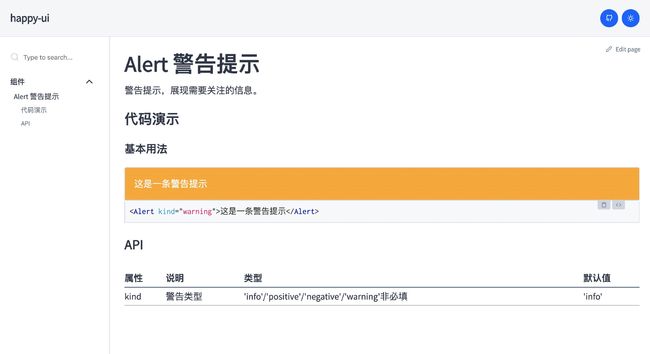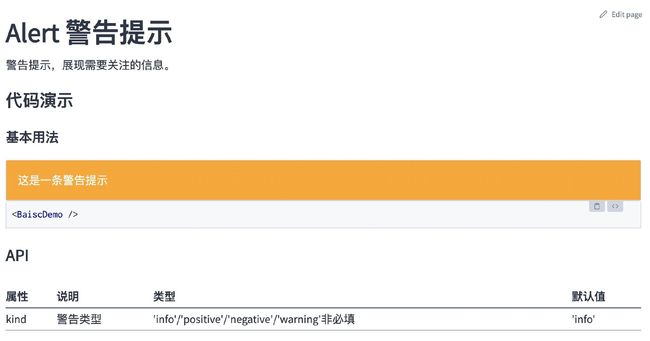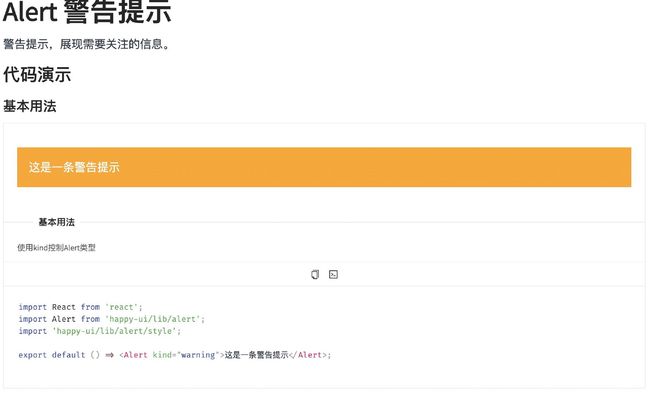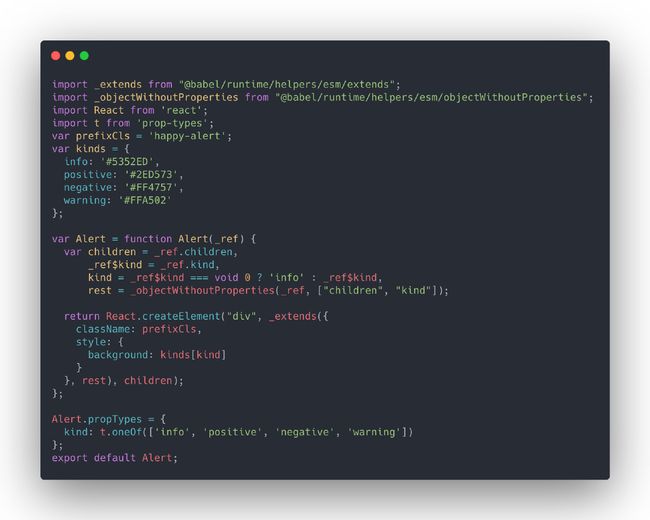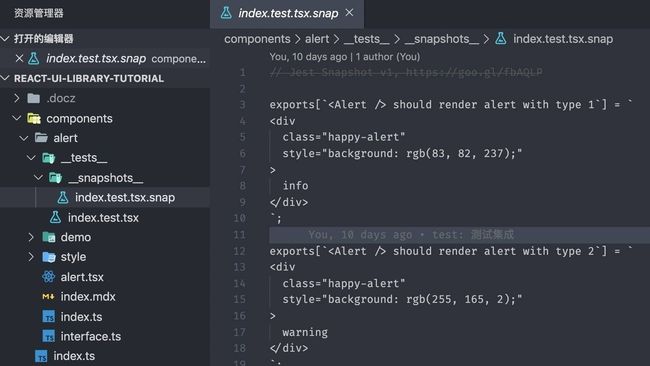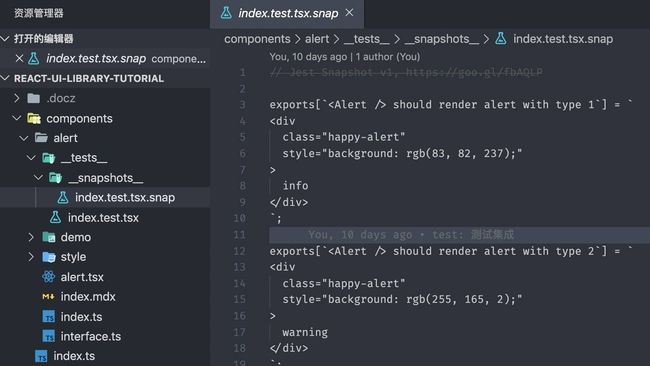在线预览:戳我
本地预览:
git clone [email protected]:worldzhao/react-ui-library-tutorial.git
cd react-ui-library-tutorial
yarn
yarn start
按顺序执行完命令后,即可在 localhost:3000 端口看到以下内容:
- 概览
- 准备工作
- 初始化项目
- 代码规范
- Commit Lint
- TypeScript
- 测试
- 开发与调试
- 安装 docz 以及自定义配置
- 编写文档
- 优化文档编写
- 优化代码展示
- 编写
- 编写
- 相关配置
- 改造相关文件
- 组件库打包
- 导出类型声明文件
- 导出 Commonjs 模块
- babel 配置
- gulp 配置
- 导出 ES module
- 处理样式文件
- 拷贝 less 文件
- 生成 css 文件
- 生成 css.js
- 按需加载
- 生成 umd
- 组件测试
- 相关配置
- 编写测试用例
- 标准化发布流程
- 初始化组件
- 结语
概览
本文包含以下内容:
- prepare: 组件库前期开发准备工作。
eslint/commit lint/typescript等等; - dev: 使用docz进行开发调试以及文档编写;
- build:
umdcjs/esm、types、polyfill 以及按需加载; - test: 组件测试;
- release: 组件库发布流程;
- deploy: 使用now部署文档站点,待补充;
- other: 使用plop.js快速创建组件模板。
如果本文帮助到了你请给仓库 一颗 ✨✨。
如果有错误烦请在评论区指正交流,谢谢。
仓库地址
准备工作
初始化项目
新建一个happy-ui文件夹,并初始化。
mkdir happy-ui
cd happy-ui
npm init --y
mkdir components && cd components && touch index.ts # 新建源码文件夹以及入口文件
代码规范
此处直接使用@umijs/fabric的配置。
yarn add @umijs/fabric --dev
yarn add prettier --dev # 因为@umijs/fabric没有将prettier作为依赖 所以我们需要手动安装
.eslintrc.js
module.exports = {
extends: [require.resolve('@umijs/fabric/dist/eslint')],
};
.prettierrc.js
const fabric = require('@umijs/fabric');
module.exports = {
...fabric.prettier,
};
.stylelintrc.js
module.exports = {
extends: [require.resolve('@umijs/fabric/dist/stylelint')],
};
想自行配置的同学可以参考以下文章:
- Linting Your React+Typescript Project with ESLint and Prettier!
- 使用 ESLint+Prettier 规范 React+Typescript 项目
Commit Lint
进行pre-commit代码规范检测。
yarn add husky lint-staged --dev
package.json
"lint-staged": {
"components/**/*.ts?(x)": [
"prettier --write",
"eslint --fix",
"git add"
],
"components/**/*.less": [
"stylelint --syntax less --fix",
"git add"
]
},
"husky": {
"hooks": {
"pre-commit": "lint-staged"
}
}
进行 Commit Message 检测。
yarn add @commitlint/cli @commitlint/config-conventional commitizen cz-conventional-changelog --dev
新增.commitlintrc.js写入以下内容
module.exports = { extends: ['@commitlint/config-conventional'] };
package.json 写入以下内容:
// ...
"scripts": {
"commit": "git-cz",
}
// ...
"husky": {
"hooks": {
"commit-msg": "commitlint -E HUSKY_GIT_PARAMS",
"pre-commit": "lint-staged"
}
},
"config": {
"commitizen": {
"path": "cz-conventional-changelog"
}
}
后续使用 yarn commit 替代 git commit生成规范的 Commit Message,当然为了效率你可以选择手写,但是要符合规范。
TypeScript
yarn add typescript --dev
新建tsconfig.json并写入以下内容
{
"compilerOptions": {
"baseUrl": "./",
"target": "esnext",
"module": "commonjs",
"jsx": "react",
"declaration": true,
"declarationDir": "lib",
"strict": true,
"moduleResolution": "node",
"allowSyntheticDefaultImports": true,
"esModuleInterop": true,
"resolveJsonModule": true
},
"include": ["components", "global.d.ts"],
"exclude": ["node_modules"]
}
测试
在components文件夹下新建alert文件夹,目录结构如下:
alert
├── alert.tsx # 源文件
├── index.ts # 入口文件
├── interface.ts # 类型声明文件
└── style
├── index.less # 样式文件
└── index.ts # 样式文件里为什么存在一个index.ts - 按需加载样式 管理样式依赖 后面章节会提到
安装React相关依赖:
yarn add react react-dom @types/react @types/react-dom --dev # 开发时依赖,宿主环境一定存在
yarn add prop-types # 运行时依赖,宿主环境可能不存在 安装本组件库时一起安装
此处依旧安装了
prop-types这个库,因为无法保证宿主环境也使用typescript,从而能够进行静态检查,故使用prop-types保证javascript用户也能得到友好的运行时报错信息。
components/alert/interface.ts
export type Kind = 'info' | 'positive' | 'negative' | 'warning';
export type KindMap = Record;
export interface AlertProps {
/**
* Set this to change alert kind
* @default info
*/
kind?: 'info' | 'positive' | 'negative' | 'warning';
}
components/alert/alter.tsx
import React from 'react';
import t from 'prop-types';
import { AlertProps, KindMap } from './interface';
const prefixCls = 'happy-alert';
const kinds: KindMap = {
info: '#5352ED',
positive: '#2ED573',
negative: '#FF4757',
warning: '#FFA502',
};
const Alert: React.FC = ({ children, kind = 'info', ...rest }) => (
{children}
);
Alert.propTypes = {
kind: t.oneOf(['info', 'positive', 'negative', 'warning']),
};
export default Alert;
components/alert/index.ts
import Alert from './alert';
export default Alert;
export * from './interface';
components/alert/style/index.less
@popupPrefix: happy-alert;
.@{popupPrefix} {
padding: 20px;
background: white;
border-radius: 3px;
color: white;
}
components/alert/style/index.ts
import './index.less';
components/index.ts
export { default as Alert } from './alert';
此处组件参考的
docz项目typescript以及less示例。
git 一把梭,可以看到控制台已经进行钩子检测了。
git add .
yarn commit # 或 git commit -m'feat: chapter-1 准备工作'
git push
准备工作完成。代码可以在仓库的chapter-1分支获取,若存在与本文内容不符的地方,以master分支以及文章为准。
开发与调试
本节解决开发组件时的预览以及调试问题,顺路解决文档编写。
此处选择docz来辅助预览调试。
docz基于MDX(Markdown + JSX),可以在 Markdown 中引入 React 组件,使得一边编写文档,一边预览调试成为了可能。而且得益于 React 组件生态,我们可以像编写应用一般编写文档,不仅仅是枯燥的文字。docz也内置了一些组件,比如。
安装 docz 以及自定义配置
yarn add docz --dev
yarn add rimraf --dev # 清空目录的一个辅助库
增加 npm scripts 至 package.json。
"scripts": {
"dev": "docz dev", // 启动本地开发环境
"start": "npm run dev", // dev命令别名
"build:doc": "rimraf doc-site && docz build", // 后续会配置打包出来的文件目录名为doc-site,故每次build前删除
"preview:doc": "docz serve" // 预览文档站点
},
注意:本节所有操作都是针对站点应用。
打包指代文档站点打包,而非组件库。
新建doczrc.js配置文件,并写入以下内容:
doczrc.js
export default {
files: './components/**/*.{md,markdown,mdx}', // 识别的文件后缀
dest: 'doc-site', // 打包出来的文件目录名
title: 'happy-ui', // 站点标题
typescript: true, // 组件源文件是通过typescript开发,需要打开此选项
};
由于使用了less作为样式预处理器,故需要安装 less 插件。
yarn add less gatsby-plugin-less --dev
新建gatsby-config.js,并写入以下内容:
gatsby-config.js
module.exports = {
plugins: ['gatsby-theme-docz', 'gatsby-plugin-less'],
};
编写文档
新建components/alert/index.mdx,并写入以下内容:
---
name: Alert 警告提示
route: /Alert
menu: 组件
---
import { Playground } from 'docz'; import Alert from './alert'; // 引入组件 import './style'; // 引入组件样式
# Alert 警告提示
警告提示,展现需要关注的信息。
## 代码演示
### 基本用法
这是一条警告提示
## API
| 属性 | 说明 | 类型 | 默认值 |
| ---- | -------- | -------------------------------------------- | ------ |
| kind | 警告类型 | 'info'/'positive'/'negative'/'warning'非必填 | 'info' |
执行脚本命令:
yarn start # or yarn dev
可以在localhost:3000看到如下页面 :
现在可以在index.mdx中愉快地进行文档编写和调试了!
优化文档编写
若代码演示部分的demo较多(比如基本用法、高级用法以及各种用法等等),在组件复杂的情况下,会导致文档源文件很长难以维护。那就抽离吧。
在components/alert/文件夹下新建demo文件夹,存放我们在编写文档时需要引用的 demo。
components/alert/demo/1-demo-basic.tsx
import React from 'react';
import Alert from '../alert';
import '../style';
export default () => components/alert/index.mdx
- import Alert from './alert'; // 引入组件
- import './style'; // 引入组件样式
+ import BasicDemo from './demo/1-demo-basic';
...
- 这是一条警告提示
+
这样我们就将 demo 与文档进行了分隔。预览如下:
等等,代码区域显示的是demo源码。
- Allow to override the playground's editor's code #906
其实第一条 PR 已经解决了问题,但是被关闭了,无奈。
不过既然都能引入 React 组件了,在MDX的环境下自定义一个Playground组件又有何难呢,无非就是渲染组件(MDX 自带)和展示源码,简单开放的东西大家都是喜闻乐见的,就叫HappyBox吧。
优化代码展示
编写
安装依赖:
yarn add react-use react-tooltip react-feather react-simple-code-editor prismjs react-copy-to-clipboard raw-loader styled-components --dev
- react-use - 2020 年了,当然要用
hooks - react-simple-code-editor - 代码展示区域
- prismjs - 代码高亮
- raw-loader - 将源码转成字符串
- react-copy-to-clipboard - 让用户爸爸们能够 copy demo 代码
- react-tooltip/react-feather 辅助组件
- styled-components 方便在文档示例中让用户看到样式,也用作文档组件的样式处理
这些依赖都是服务于文档站点应用,和组件库自身毫无关联。
最终效果如下:
根目录下新建doc-comps文件夹,存放文档中使用的一些工具组件,比如
doc-comps
├── happy-box
│ ├── style.ts
│ └── index.tsx
└── index.ts
components/doc-comps/happy-box/index.tsx
展开查看代码
import React from 'react';
import Editor from 'react-simple-code-editor';
import CopyToClipboard from 'react-copy-to-clipboard';
import { useToggle } from 'react-use';
import ReactTooltip from 'react-tooltip';
import IconCopy from 'react-feather/dist/icons/clipboard';
import IconCode from 'react-feather/dist/icons/code';
import { highlight, languages } from 'prismjs/components/prism-core';
import { StyledContainer, StyledIconWrapper } from './style';
import 'prismjs/components/prism-clike';
import 'prismjs/components/prism-javascript';
import 'prismjs/components/prism-markup';
require('prismjs/components/prism-jsx');
interface Props {
code: string;
title?: React.ReactNode;
desc?: React.ReactNode;
}
export const HappyBox: React.FC = ({ code, title, desc, children }) => {
const [isEditVisible, toggleEditVisible] = useToggle(false);
return (
{children}
{title || '示例'}
{desc || '暂无描述'}
alert('复制成功')}>
{renderEditor()}
);
function renderEditor() {
if (!isEditVisible) return null;
return (
{}}
highlight={code => highlight(code, languages.jsx)}
padding={10}
className="container__editor"
style={{
fontFamily: '"Fira code", "Fira Mono", monospace',
fontSize: 14,
}}
/>
);
}
};
export default HappyBox;
components/doc-comps/happy-box/style.ts
展开查看代码
import styled from 'styled-components';
export const StyledIconWrapper = styled.div`
display: flex;
align-items: center;
margin-left: 10px;
`;
export const StyledContainer = styled.div`
position: relative;
display: inline-block;
width: 100%;
margin: 0 0 16px;
border: 1px solid #ebedf0;
border-radius: 2px;
transition: all 0.2s;
.text-divider {
display: table;
&::before,
&::after {
content: '';
position: relative;
display: table-cell;
transform: translateY(50%);
content: '';
border-top: 1px solid #e8e8e8;
}
&::before {
top: 50%;
width: 5%;
}
&::after {
width: 95%;
top: 50%;
width: 95%;
}
& > span {
display: inline-block;
padding: 0 10px;
font-weight: 500;
font-size: 16px;
white-space: nowrap;
text-align: center;
font-variant: tabular-nums;
line-height: 1.5;
}
}
.divider {
margin: 0;
background: none;
border: dashed #e8e8e8;
border-width: 1px 0 0;
display: block;
clear: both;
width: 100%;
min-width: 100%;
height: 1px;
position: relative;
top: -0.06em;
box-sizing: border-box;
padding: 0;
font-size: 14px;
font-variant: tabular-nums;
line-height: 1.5;
list-style: none;
font-feature-settings: 'tnum';
}
.code-box-demo {
transition: all 0.2s;
padding: 42px 24px 50px;
}
.code-box-meta {
font-size: 14px;
line-height: 2;
}
.code-box .ant-divider {
margin: 0;
}
.code-box-description {
padding: 18px 24px 12px;
}
.code-box-action {
height: 40px;
display: flex;
align-items: center;
justify-content: center;
font-size: 16px;
}
.code-box-action .anticon {
margin: 0 8px;
cursor: pointer;
}
.container_editor_area {
border-top: 1px solid rgb(232, 232, 232);
padding: 16px;
}
.container__editor {
font-variant-ligatures: common-ligatures;
border-radius: 3px;
}
.container__editor textarea {
outline: 0;
background-color: none;
}
.button {
display: inline-block;
padding: 0 6px;
text-decoration: none;
background: #000;
color: #fff;
}
.button:hover {
background: linear-gradient(45deg, #e42b66, #e2433f);
}
/* Syntax highlighting */
.token.comment,
.token.prolog,
.token.doctype,
.token.cdata {
color: #90a4ae;
}
.token.punctuation {
color: #9e9e9e;
}
.namespace {
opacity: 0.7;
}
.token.property,
.token.tag,
.token.boolean,
.token.number,
.token.constant,
.token.symbol,
.token.deleted {
color: #e91e63;
}
.token.selector,
.token.attr-name,
.token.string,
.token.char,
.token.builtin,
.token.inserted {
color: #4caf50;
}
.token.operator,
.token.entity,
.token.url,
.language-css .token.string,
.style .token.string {
color: #795548;
}
.token.atrule,
.token.attr-value,
.token.keyword {
color: #3f51b5;
}
.token.function {
color: #f44336;
}
.token.regex,
.token.important,
.token.variable {
color: #ff9800;
}
.token.important,
.token.bold {
font-weight: bold;
}
.token.italic {
font-style: italic;
}
.token.entity {
cursor: help;
}
`;
相关配置
- 增加
alias别名,样例源码展示相对路径不够友好,让用户直接拷贝才够省心
新建gatsby-node.js,写入以下内容以开启alias:
const path = require('path');
exports.onCreateWebpackConfig = args => {
args.actions.setWebpackConfig({
resolve: {
modules: [path.resolve(__dirname, '../src'), 'node_modules'],
alias: {
'happy-ui/lib': path.resolve(__dirname, '../components/'),
'happy-ui/esm': path.resolve(__dirname, '../components/'),
'happy-ui': path.resolve(__dirname, '../components/'),
},
},
});
};
tsconfig.json 打包时需要忽略demo,避免组件库打包生成types时包含其中,同时增加paths属性用于 vscode 自动提示:
tsconfig.json
{
"compilerOptions": {
"baseUrl": "./",
+ "paths": {
+ "happy-ui": ["components/index.ts"],
+ "happy-ui/esm/*": ["components/*"],
+ "happy-ui/lib/*": ["components/*"]
+ },
"target": "esnext",
"module": "commonjs",
"jsx": "react",
"declaration": true,
"declarationDir": "lib",
"strict": true,
"moduleResolution": "node",
"allowSyntheticDefaultImports": true,
"esModuleInterop": true,
"resolveJsonModule": true
},
"include": ["components", "global.d.ts"],
- "exclude": ["node_modules"]
+ "exclude": ["node_modules", "**/demo/**"]
}
新的问题出现了,vscode 的 alias 提示依赖 tsconfig.json,忽略 demo 文件夹后,demo 内的文件模块类型找不到声明(paths 失效),所以不能将 demo 在 tsconfig.json 中移除:
{
- "exclude": ["node_modules", "**/demo/**"]
+ "exclude": ["node_modules"]
}
新建一个 tsconfig.build.json 文件:
tsconfig.build.json
{
"extends": "./tsconfig.json",
"exclude": ["**/demo/**", "node_modules"]
}
后续使用 tsc 生成类型声明文件指定tsconfig.build.json即可。
改造相关文件
components/alert/demo/1-demo-basic.tsx
- import Alert from '../alert';
+ import Alert from 'happy-ui/lib/alert';
- import '../style';
+ import 'happy-ui/lib/alert/style';
components/alert/index.mdx
- import { Playground } from 'docz';
+ import { HappyBox } from '../../doc-comps';
+ import BasicDemoCode from '!raw-loader!./demo/1-demo-basic.tsx';
...
-
-
+
+
yarn start卡住时尝试删除根目录.docz文件夹,而后重新执行命令。
现在可以愉快地开发组件了。代码可以在仓库的chapter-2分支获取,若存在与本文内容不符的地方,以master分支以及文章为准。
组件库打包
宿主环境各不相同,需要将源码进行相关处理后发布至 npm。
明确以下目标:
- 导出类型声明文件;
- 导出
umd/Commonjs module/ES module等 3 种形式供使用者引入; - 支持样式文件
css引入,而非只有less,减少业务方接入成本; - 支持按需加载。
导出类型声明文件
既然是使用typescript编写的组件库,那么使用者应当享受到类型系统的好处。
我们可以生成类型声明文件,并在package.json中定义入口,如下:
package.json
{
"typings": "lib/index.d.ts", // 定义类型入口文件
"scripts": {
"build:types": "tsc -p tsconfig.build.json && cpr lib esm" // 执行tsc命令生成类型声明文件
}
}
值得注意的是:此处使用
cpr(需要手动安装)将lib的声明文件拷贝了一份,并将文件夹重命名为esm,用于后面存放 ES module 形式的组件。这样做的原因是保证用户手动按需引入组件时依旧可以获取自动提示。
最开始的方式是将声明文件单独存放在
types文件夹,但这样只有通过'happy-ui'引入才可以获取提示,而'happy-ui/esm/xxx'和'happy-ui/lib/xxx'就无法获取提示。
tsconfig.build.json
{
"extends": "./tsconfig.json",
"compilerOptions": { "emitDeclarationOnly": true }, // 只生成声明文件
"exclude": ["**/__tests__/**", "**/demo/**", "node_modules", "lib", "esm"] // 排除示例、测试以及打包好的文件夹
}
执行yarn build:types,可以发现根目录下已经生成了lib文件夹(tsconfig.json中定义的declarationDir字段)以及esm文件夹(拷贝而来),目录结构与components文件夹保持一致,如下:
lib
├── alert
│ ├── alert.d.ts
│ ├── index.d.ts
│ ├── interface.d.ts
│ └── style
│ └── index.d.ts
└── index.d.ts
这样使用者引入npm 包时,便能得到自动提示,也能够复用相关组件的类型定义。
接下来将ts(x)等文件处理成js文件。
需要注意的是,我们需要输出
Commonjs module以及ES module两种模块类型的文件(暂不考虑umd),以下使用cjs指代Commonjs module,esm指代ES module。
对此有疑问的同学推荐阅读:import、require、export、module.exports 混合详解
导出 Commonjs 模块
其实完全可以使用babel或tsc命令行工具进行代码编译处理(实际上很多工具库就是这样做的),但考虑到还要样式处理及其按需加载,我们借助 gulp 来串起这个流程。
babel 配置
首先安装babel及其相关依赖
yarn add @babel/core @babel/preset-env @babel/preset-react @babel/preset-typescript @babel/plugin-proposal-class-properties @babel/plugin-transform-runtime --dev
yarn add @babel/runtime-corejs3
新建.babelrc.js文件,写入以下内容:
.babelrc.js
module.exports = {
presets: ['@babel/env', '@babel/typescript', '@babel/react'],
plugins: [
'@babel/proposal-class-properties',
[
'@babel/plugin-transform-runtime',
{
corejs: 3,
helpers: true,
},
],
],
};
关于@babel/plugin-transform-runtime与@babel/runtime-corejs3:
- 若
helpers选项设置为true,可抽离代码编译过程重复生成的helper函数(classCallCheck,extends等),减小生成的代码体积; - 若
corejs设置为3,可引入不污染全局的按需polyfill,常用于类库编写(我更推荐:不引入polyfill,转而告知使用者需要引入何种polyfill,避免重复引入或产生冲突,后面会详细提到)。
更多参见官方文档-@babel/plugin-transform-runtime
配置目标环境
为了避免转译浏览器原生支持的语法,新建.browserslistrc文件,根据适配需求,写入支持浏览器范围,作用于@babel/preset-env。
.browserslistrc
>0.2%
not dead
not op_mini all
很遗憾的是,@babel/runtime-corejs3无法在按需引入的基础上根据目标浏览器支持程度再次减少polyfill的引入,参见@babel/runtime for target environment 。
这意味着@babel/runtime-corejs3 甚至会在针对现代引擎的情况下注入所有可能的 polyfill:不必要地增加了最终捆绑包的大小。
对于组件库(代码量可能很大),个人建议将polyfill的选择权交还给使用者,在宿主环境进行polyfill。若使用者具有兼容性要求,自然会使用@babel/preset-env + core-js + .browserslistrc进行全局polyfill,这套组合拳引入了最低目标浏览器不支持API的全部 polyfill。
顺带一提,业务开发中,若将
@babel/preset-env的useBuiltIns选项值设置为usage,同时把node_modules从babel-loader中exclude,会导致babel无法检测到nodes_modules中所需要的polyfill。"useBuiltIns: usage" for node_modules without transpiling #9419,在未支持该issue提到的内容之前,请将useBuiltIns设置为entry,或者不要把node_modules从babel-loader中exclude。
所以组件库不用画蛇添足,引入多余的polyfill,写好文档说明,比什么都重要(就像zent和antd这样)。
现在@babel/runtime-corejs3更换为@babel/runtime,只进行helper函数抽离。
yarn remove @babel/runtime-corejs3
yarn add @babel/runtime
.babelrc.js
module.exports = {
presets: ['@babel/env', '@babel/typescript', '@babel/react'],
plugins: ['@babel/plugin-transform-runtime', '@babel/proposal-class-properties'],
};
@babel/transform-runtime的helper选项默认为true。
gulp 配置
再来安装gulp相关依赖
yarn add gulp gulp-babel --dev
新建gulpfile.js,写入以下内容:
gulpfile.js
const gulp = require('gulp');
const babel = require('gulp-babel');
const paths = {
dest: {
lib: 'lib', // commonjs 文件存放的目录名 - 本块关注
esm: 'esm', // ES module 文件存放的目录名 - 暂时不关心
dist: 'dist', // umd文件存放的目录名 - 暂时不关心
},
styles: 'components/**/*.less', // 样式文件路径 - 暂时不关心
scripts: ['components/**/*.{ts,tsx}', '!components/**/demo/*.{ts,tsx}'], // 脚本文件路径
};
function compileCJS() {
const { dest, scripts } = paths;
return gulp
.src(scripts)
.pipe(babel()) // 使用gulp-babel处理
.pipe(gulp.dest(dest.lib));
}
// 并行任务 后续加入样式处理 可以并行处理
const build = gulp.parallel(compileCJS);
exports.build = build;
exports.default = build;
修改package.json
package.json
{
- "main": "index.js",
+ "main": "lib/index.js",
"scripts": {
...
+ "clean": "rimraf lib esm dist",
+ "build": "npm run clean && npm run build:types && gulp",
...
},
}
执行yarn build,得到如下内容:
lib
├── alert
│ ├── alert.js
│ ├── index.js
│ ├── interface.js
│ └── style
│ └── index.js
└── index.js
观察编译后的源码,可以发现:诸多helper方法已被抽离至@babel/runtime中,模块导入导出形式也是commonjs规范。
lib/alert/alert.js
导出 ES module
生成ES module可以更好地进行tree shaking,基于上一步的babel配置,更新以下内容:
- 配置
@babel/preset-env的modules选项为false,关闭模块转换; - 配置
@babel/plugin-transform-runtime的useESModules选项为true,使用ES module形式引入helper函数。
.babelrc.js
module.exports = {
presets: [
[
'@babel/env',
{
modules: false, // 关闭模块转换
},
],
'@babel/typescript',
'@babel/react',
],
plugins: [
'@babel/proposal-class-properties',
[
'@babel/plugin-transform-runtime',
{
useESModules: true, // 使用esm形式的helper
},
],
],
};
目标达成,我们再使用环境变量区分esm和cjs(执行任务时设置对应的环境变量即可),最终babel配置如下:
.babelrc.js
module.exports = {
presets: ['@babel/env', '@babel/typescript', '@babel/react'],
plugins: ['@babel/plugin-transform-runtime', '@babel/proposal-class-properties'],
env: {
esm: {
presets: [
[
'@babel/env',
{
modules: false,
},
],
],
plugins: [
[
'@babel/plugin-transform-runtime',
{
useESModules: true,
},
],
],
},
},
};
接下来修改gulp相关配置,抽离compileScripts任务,增加compileESM任务。
gulpfile.js
// ...
/**
* 编译脚本文件
* @param {string} babelEnv babel环境变量
* @param {string} destDir 目标目录
*/
function compileScripts(babelEnv, destDir) {
const { scripts } = paths;
// 设置环境变量
process.env.BABEL_ENV = babelEnv;
return gulp
.src(scripts)
.pipe(babel()) // 使用gulp-babel处理
.pipe(gulp.dest(destDir));
}
/**
* 编译cjs
*/
function compileCJS() {
const { dest } = paths;
return compileScripts('cjs', dest.lib);
}
/**
* 编译esm
*/
function compileESM() {
const { dest } = paths;
return compileScripts('esm', dest.esm);
}
// 串行执行编译脚本任务(cjs,esm) 避免环境变量影响
const buildScripts = gulp.series(compileCJS, compileESM);
// 整体并行执行任务
const build = gulp.parallel(buildScripts);
// ...
执行yarn build,可以发现生成了lib/esm两个文件夹,观察esm目录,结构同lib一致,js 文件都是以ES module模块形式导入导出。
esm/alert/alert.js
别忘了给package.json增加相关入口。
package.json
{
+ "module": "esm/index.js"
}
处理样式文件
拷贝 less 文件
我们会将less文件包含在npm包中,用户可以通过happy-ui/lib/alert/style/index.js的形式按需引入less文件,此处可以直接将 less 文件拷贝至目标文件夹。
在gulpfile.js中新建copyLess任务。
gulpfile.js
// ...
/**
* 拷贝less文件
*/
function copyLess() {
return gulp
.src(paths.styles)
.pipe(gulp.dest(paths.dest.lib))
.pipe(gulp.dest(paths.dest.esm));
}
const build = gulp.parallel(buildScripts, copyLess);
// ...
观察lib目录,可以发现 less 文件已被拷贝至alert/style目录下。
lib
├── alert
│ ├── alert.js
│ ├── index.js
│ ├── interface.js
│ └── style
│ ├── index.js
│ └── index.less # less文件
└── index.js
可能有些同学已经发现问题:若使用者没有使用less预处理器,使用的是sass方案甚至原生css方案,那现有方案就搞不定了。经分析,有以下 4 种预选方案:
- 告知业务方增加
less-loader。会导致业务方使用成本增加; - 打包出一份完整的
css文件,进行全量引入。无法进行按需引入; -
css in js方案; - 提供一份
style/css.js文件,引入组件css样式依赖,而非less依赖,组件库底层抹平差异。
重点看一看方案 3 以及方案 4。
css in js除了赋予样式编写更多的可能性之外,在编写第三方组件库时更是利器。
如果我们写一个react-use这种hooks工具库,不涉及到样式,只需要在package.json中设置sideEffects为false,业务方使用 webpack 进行打包时,只会打包被使用到的 hooks(优先使用 ES module)。
入口文件index.js中导出的但未被使用的其他 hooks 会被tree shaking,第一次使用这个库的时候我很好奇,为什么没有按需引入的使用方式,结果打包分析时我傻了,原来人家天生支持按需引入。
可能常用的antd以及lodash都要配一配,导致产生了惯性思维。
回到正题。如果将样式使用javascript来编写,在某种维度上讲,组件库和工具库一致了,配好sideEffects,自动按需引入,美滋滋。
而且每个组件都与自己的样式绑定,不需要业务方或组件开发者去维护样式依赖,什么是样式依赖,后面会讲到。
缺点:
- 样式无法单独缓存;
- styled-components 自身体积较大;
- 复写组件样式需要使用属性选择器或者使用
styled-components自带方法。
需要看取舍了,偷偷说一句styled-components做主题定制也极其方便。
方案 4 是antd使用的这种方案。
在搭建组件库的过程中,有一个问题困扰了我很久:为什么需要alert/style/index.js引入less文件或alert/style/css.js引入css文件?
答案是管理样式依赖。
因为我们的组件是没有引入样式文件的,需要使用者去手动引入。
假设存在以下场景:使用者引入,依赖了)及其依赖的组件样式(js文件,使用者手动引入这个js文件,就能引入对应组件及其依赖组件的样式。
那么问题又来了,为什么组件不能自己去import './index.less'呢?
可以,但业务方需要配置less-loader,什么,业务方不想配,要你import './index.css'?
可以,业务方爽了,组件开发者不开心。
所以我们要找一个大家都爽的方案:
- 组件开发者能够开心的使用预处理器;
- 业务方不需要额外的使用成本。
答案就是css in js单独提供一份style/css.js文件,引入的是组件 css样式文件依赖,而非 less 依赖,组件库底层抹平差异。
之前了解到father可以在打包的时候将index.less转成index.css,这倒是个好法子,但是一些重复引入的样式模块(比如动画样式),会被重复打包,不知道有没有好的解决方案。
生成 css 文件
安装相关依赖。
yarn add gulp-less gulp-autoprefixer gulp-cssnano --dev
将less文件生成对应的css文件,在gulpfile.js中增加less2css任务。
// ...
/**
* 生成css文件
*/
function less2css() {
return gulp
.src(paths.styles)
.pipe(less()) // 处理less文件
.pipe(autoprefixer()) // 根据browserslistrc增加前缀
.pipe(cssnano({ zindex: false, reduceIdents: false })) // 压缩
.pipe(gulp.dest(paths.dest.lib))
.pipe(gulp.dest(paths.dest.esm));
}
const build = gulp.parallel(buildScripts, copyLess, less2css);
// ...
执行yarn build,组件style目录下已经存在css文件了。
接下来我们需要一个alert/style/css.js来帮用户引入css文件。
生成 css.js
此处参考antd-tools的实现方式:在处理scripts任务中,截住style/index.js,生成style/css.js,并通过正则将引入的less文件后缀改成css。
安装相关依赖。
yarn add through2 --dev
gulpfile.js
// ...
/**
* 编译脚本文件
* @param {*} babelEnv babel环境变量
* @param {*} destDir 目标目录
*/
function compileScripts(babelEnv, destDir) {
const { scripts } = paths;
process.env.BABEL_ENV = babelEnv;
return gulp
.src(scripts)
.pipe(babel()) // 使用gulp-babel处理
.pipe(
through2.obj(function z(file, encoding, next) {
this.push(file.clone());
// 找到目标
if (file.path.match(/(\/|\\)style(\/|\\)index\.js/)) {
const content = file.contents.toString(encoding);
file.contents = Buffer.from(cssInjection(content)); // 文件内容处理
file.path = file.path.replace(/index\.js/, 'css.js'); // 文件重命名
this.push(file); // 新增该文件
next();
} else {
next();
}
}),
)
.pipe(gulp.dest(destDir));
}
// ...
cssInjection的实现:
gulpfile.js
/**
* 当前组件样式 import './index.less' => import './index.css'
* 依赖的其他组件样式 import '../test-comp/style' => import '../test-comp/style/css.js'
* 依赖的其他组件样式 import '../test-comp/style/index.js' => import '../test-comp/style/css.js'
* @param {string} content
*/
function cssInjection(content) {
return content
.replace(/\/style\/?'/g, "/style/css'")
.replace(/\/style\/?"/g, '/style/css"')
.replace(/\.less/g, '.css');
}
再进行打包,可以看见组件style目录下生成了css.js文件,引入的也是上一步less转换而来的css文件。
lib/alert
├── alert.js
├── index.js
├── interface.js
└── style
├── css.js # 引入index.css
├── index.css
├── index.js
└── index.less
按需加载
在 package.json 中增加sideEffects属性,配合ES module达到tree shaking效果(将样式依赖文件标注为side effects,避免被误删除)。
// ...
"sideEffects": [
"dist/*",
"esm/**/style/*",
"lib/**/style/*",
"*.less"
],
// ...
使用以下方式引入,可以做到js部分的按需加载,但需要手动引入样式:
import { Alert } from 'happy-ui';
import 'happy-ui/esm/alert/style';
也可以使用以下方式引入:
import Alert from 'happy-ui/esm/alert'; // or import Alert from 'happy-ui/lib/alert';
import 'happy-ui/esm/alert/style'; // or import Alert from 'happy-ui/lib/alert';
以上引入样式文件的方式不太优雅,直接入口处引入全量样式文件又和按需加载的本意相去甚远。
使用者可以借助babel-plugin-import来进行辅助,减少代码编写量(说好的不加入其他使用成本的呢~)。
import { Alert } from 'happy-ui';
⬇️
import Alert from 'happy-ui/lib/alert';
import 'happy-ui/lib/alert/style';
生成 umd
没用上,这一块标记为 todo 吧。
本节代码可以在仓库的chapter-3分支获取,若存在与本文内容不符的地方,以master分支以及文章为准。
组件测试
与软件操作行为越接近的测试,越能给予你信心。
本节主要讲述如何在组件库中引入jest以及@testing-library/react,而不会深入单元测试的学习。
如果你对下列问题感兴趣:
- What-单元测试是什么?
- Why-为什么要写单元测试?
- How-编写单元测试的最佳实践?
那么可以看看以下文章:
- Test React apps with React Testing Library:通过一个
React Testing Library而非Enzyme的理由,并对其进行了一些入门教学; - React Testing Library:
@testing-library/react的官方文档,该库提供的 API 在某个程度上就是在指引开发者进行单元测试的最佳实践; - React Testing Library-examples:
@testing-library/react的一些实例,提供了各种常见场景的测试; - React 单元测试策略及落地:如标题所示,值得一看。
相关配置
安装依赖:
yarn add jest ts-jest @testing-library/react @testing-library/jest-dom identity-obj-proxy @types/jest @types/testing-library__react --dev
- jest: JavaScript 测试框架,专注于简洁明快;
- ts-jest:为
TypeScript编写jest测试用例提供支持; - @testing-library/react:简单而完整的
React DOM测试工具,鼓励良好的测试实践; - @testing-library/jest-dom:自定义的
jest匹配器(matchers),用于测试DOM的状态(即为jest的except方法返回值增加更多专注于DOM的matchers); - identity-obj-proxy:一个工具库,此处用来
mock样式文件。
新建jest.config.js,并写入相关配置,更多配置可参考jest 官方文档-配置,只看几个常用的就可以。
jest.config.js
module.exports = {
verbose: true,
roots: ['/components'],
moduleNameMapper: {
'\\.(css|less|scss)$': 'identity-obj-proxy',
'^components$': '/components/index.tsx',
'^components(.*)$': '/components/$1',
},
testRegex: '(/test/.*|\\.(test|spec))\\.(ts|tsx|js)$',
moduleFileExtensions: ['ts', 'tsx', 'js', 'jsx'],
testPathIgnorePatterns: ['/node_modules/', '/lib/', '/esm/', '/dist/'],
preset: 'ts-jest',
testEnvironment: 'jsdom',
};
修改package.json,增加测试相关命令,并且代码提交前,跑测试用例,如下:
package.json
"scripts": {
...
+ "test": "jest", # 执行jest
+ "test:watch": "jest --watch", # watch模式下执行
+ "test:coverage": "jest --coverage", # 生成测试覆盖率报告
+ "test:update": "jest --updateSnapshot" # 更新快照
},
...
"lint-staged": {
"components/**/*.ts?(x)": [
"prettier --write",
"eslint --fix",
+ "jest --bail --findRelatedTests",
"git add"
],
...
}
修改gulpfile.js以及tsconfig.json,避免打包时,把测试文件一并处理了。
gulpfile.js
const paths = {
...
- scripts: ['components/**/*.{ts,tsx}', '!components/**/demo/*.{ts,tsx}'],
+ scripts: [
+ 'components/**/*.{ts,tsx}',
+ '!components/**/demo/*.{ts,tsx}',
+ '!components/**/__tests__/*.{ts,tsx}',
+ ],
};
tsconfig.json
{
- "exclude": ["components/**/demo"]
+ "exclude": ["components/**/demo", "components/**/__tests__"]
}
编写测试用例
在对应组件的文件夹下新建__tests__文件夹,用于存放测试文件,其内新建index.test.tsx文件,写入以下测试用例:
components/alert/tests/index.test.tsx
import React from 'react';
import { render } from '@testing-library/react';
import Alert from '../alert';
describe('default );
expect(container).toMatchSnapshot();
});
test('should render alert with type', () => {
const kinds: any[] = ['info', 'warning', 'positive', 'negative'];
const { getByText } = render(
<>
{kinds.map(k => (
{k}
))}
,
);
kinds.forEach(k => {
expect(getByText(k)).toMatchSnapshot();
});
});
});
更新一下快照:
yarn test:update
可以看见同级目录下新增了一个__snapshots__文件夹,里面存放对应测试用例的快照文件。
再执行测试用例:
yarn test
可以发现我们通过了测试用例。。。额,这里当然能通过,主要是后续我们进行迭代重构时,都会重新执行测试用例,与最近的一次快照进行比对,如果与快照不一致(结构发生了改变),那么相应的测试用例就无法通过。
对于快照测试,褒贬不一,这个例子也着实简单得很,甚至连扩展的 jest-dom提供的 matchers 都没用上。
如何编写优秀的测试用例,我也是一个新手,只能说多看多写多尝试,前面推荐的文章很不错。
本节代码可以在仓库的chapter-4分支获取,若存在与本文内容不符的地方,以master分支以及文章为准。
标准化发布流程
本节主要是讲解如何通过一行命令完成以下六点内容:
- 版本更新
- 生成 CHANGELOG
- 推送至 git 仓库
- 组件库打包
- 发布至 npm
- 打 tag 并推送至 git
package.json
"scripts": {
+ "release": "ts-node ./scripts/release.ts"
},
展开查看代码
/* eslint-disable import/no-extraneous-dependencies,@typescript-eslint/camelcase, no-console */
import inquirer from 'inquirer';
import fs from 'fs';
import path from 'path';
import child_process from 'child_process';
import util from 'util';
import chalk from 'chalk';
import semverInc from 'semver/functions/inc';
import { ReleaseType } from 'semver';
import pkg from '../package.json';
const exec = util.promisify(child_process.exec);
const run = async (command: string) => {
console.log(chalk.green(command));
await exec(command);
};
const currentVersion = pkg.version;
const getNextVersions = (): { [key in ReleaseType]: string | null } => ({
major: semverInc(currentVersion, 'major'),
minor: semverInc(currentVersion, 'minor'),
patch: semverInc(currentVersion, 'patch'),
premajor: semverInc(currentVersion, 'premajor'),
preminor: semverInc(currentVersion, 'preminor'),
prepatch: semverInc(currentVersion, 'prepatch'),
prerelease: semverInc(currentVersion, 'prerelease'),
});
const timeLog = (logInfo: string, type: 'start' | 'end') => {
let info = '';
if (type === 'start') {
info = `=> 开始任务:${logInfo}`;
} else {
info = `✨ 结束任务:${logInfo}`;
}
const nowDate = new Date();
console.log(
`[${nowDate.toLocaleString()}.${nowDate
.getMilliseconds()
.toString()
.padStart(3, '0')}] ${info}
`,
);
};
/**
* 询问获取下一次版本号
*/
async function prompt(): Promise {
const nextVersions = getNextVersions();
const { nextVersion } = await inquirer.prompt([
{
type: 'list',
name: 'nextVersion',
message: `请选择将要发布的版本 (当前版本 ${currentVersion})`,
choices: (Object.keys(nextVersions) as Array).map(level => ({
name: `${level} => ${nextVersions[level]}`,
value: nextVersions[level],
})),
},
]);
return nextVersion;
}
/**
* 更新版本号
* @param nextVersion 新版本号
*/
async function updateVersion(nextVersion: string) {
pkg.version = nextVersion;
timeLog('修改package.json版本号', 'start');
await fs.writeFileSync(path.resolve(__dirname, './../package.json'), JSON.stringify(pkg));
await run('npx prettier package.json --write');
timeLog('修改package.json版本号', 'end');
}
/**
* 生成CHANGELOG
*/
async function generateChangelog() {
timeLog('生成CHANGELOG.md', 'start');
await run(' npx conventional-changelog -p angular -i CHANGELOG.md -s -r 0');
timeLog('生成CHANGELOG.md', 'end');
}
/**
* 将代码提交至git
*/
async function push(nextVersion: string) {
timeLog('推送代码至git仓库', 'start');
await run('git add package.json CHANGELOG.md');
await run(`git commit -m "v${nextVersion}" -n`);
await run('git push');
timeLog('推送代码至git仓库', 'end');
}
/**
* 组件库打包
*/
async function build() {
timeLog('组件库打包', 'start');
await run('npm run build');
timeLog('组件库打包', 'end');
}
/**
* 发布至npm
*/
async function publish() {
timeLog('发布组件库', 'start');
await run('npm publish');
timeLog('发布组件库', 'end');
}
/**
* 打tag提交至git
*/
async function tag(nextVersion: string) {
timeLog('打tag并推送至git', 'start');
await run(`git tag v${nextVersion}`);
await run(`git push origin tag v${nextVersion}`);
timeLog('打tag并推送至git', 'end');
}
async function main() {
try {
const nextVersion = await prompt();
const startTime = Date.now();
// =================== 更新版本号 ===================
await updateVersion(nextVersion);
// =================== 更新changelog ===================
await generateChangelog();
// =================== 代码推送git仓库 ===================
await push(nextVersion);
// =================== 组件库打包 ===================
await build();
// =================== 发布至npm ===================
await publish();
// =================== 打tag并推送至git ===================
await tag(nextVersion);
console.log(`✨ 发布流程结束 共耗时${((Date.now() - startTime) / 1000).toFixed(3)}s`);
} catch (error) {
console.log(' 发布失败,失败原因:', error);
}
}
main();
如果你对这一节不感兴趣,也可以直接使用np进行发布,需要自定义配置一些钩子。
初始化组件
每次初始化一个组件就要新建许多文件(夹),复制粘贴也可,不过还可以使用更高级一点的偷懒方式。
思路如下:
- 创建组件模板,预留动态信息插槽(组件名称,组件描述等等);
- 基于
inquirer.js询问动态信息; - 将信息插入模板,渲染至
components文件夹下; - 向 components/index.ts 插入导出语句。
我们只需要配置好模板以及问题,至于询问以及渲染就交给plop.js吧。
yarn add plop --dev
新增脚本命令。
package.json
"scripts": {
+ "new": "plop --plopfile ./scripts/plopfile.ts",
},
新增配置文件以及组件模板,详情可见:
- 配置文件:scripts/plopfile.ts
- 模板文件:templates/component
结语
文章很长,也是我个人学习中的总结,如果本文帮助到了你请给仓库一颗 ✨✨ 和本文一个赞。
如果有错误烦请在评论区指正交流,谢谢。
仓库地址

